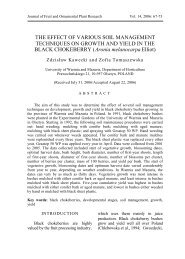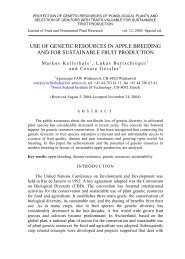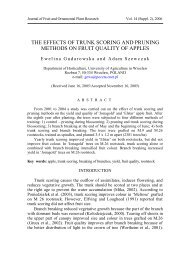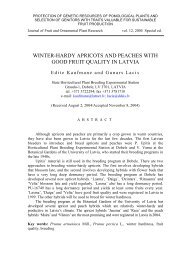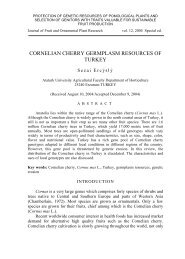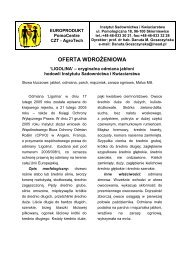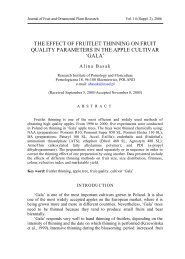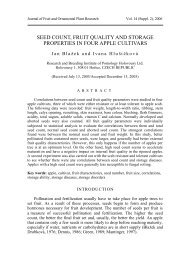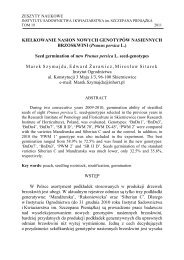MICROCLONAL PROPAGATION OF Vaccinium SP. AND Rubus SP ...
MICROCLONAL PROPAGATION OF Vaccinium SP. AND Rubus SP ...
MICROCLONAL PROPAGATION OF Vaccinium SP. AND Rubus SP ...
You also want an ePaper? Increase the reach of your titles
YUMPU automatically turns print PDFs into web optimized ePapers that Google loves.
Microclonal propagation of <strong>Vaccinium</strong> sp. and <strong>Rubus</strong> sp. …very efficient. The number of propagules which can be produced is limited byseasonal growth rate. <strong>Rubus</strong> species are susceptible to a wide variety of viraland fungal diseases. For this reason, plantations should be planted at higheraltitudes. Intensive <strong>Rubus</strong> breeding and propagation programs are underway atthe Research Institute of Fruit and Ornamental Plants in Bojnice in westernSlovakia.When establishing commercial berry plantations, it is essential to plantcertified pathogen-free new cultivars which produce well at higher elevations.Microbial pathogens can be transferred during vegetative propagation ofplants. Traditional propagation methods are also not very efficient in terms ofthe number of propagules generated. These limitations can be overcome bythe use of in vitro techniques, which ensure a reliable supply of healthy,pathogen-free planting material (Tsao et al., 2000; O‘Herlihy et al., 2003).The aim of this study was to develop and test efficient in vitroregeneration and propagation systems which can be used with high-bushblueberry, lingonberry and raspberry cultivars. Another goal was to evaluateRAPD as an inexpensive technique to identify <strong>Vaccinium</strong> cultivars and togenetically characterize clones derived from in vitro culture. Flow-cytometrywas used to evaluate clonal fidelity and variability in vegetatively propagatedplant material which had been cultured in vitro for several months.MATERIAL <strong>AND</strong> METHODSFive high-bush blueberry, two lingonberry, and six raspberry cultivarswere evaluated in terms of their regeneration capacity when propagated invitro.The high-bush blueberry cultivars tested were: ‘Berkeley’, ‘Bluecrop’,‘Blueray’, ‘Duke’ and ‘Brigitta’. The lingonberry cultivars tested were: ‘RedPearl’, ‘Koralle’. The raspberry cultivars tested were: ‘Bojana’, ‘Afrodita’,‘Granát’, ‘Ada’, ‘Medea’ and ‘Bulharský Rubín’.Shoots were regenerated directly from isolated meristems, dormant apicalbuds, and dormant axillary buds. Stem cutting with dormant buds werecollected in January and February from mature plants growing in the field.Nodal segments bearing one bud apiece were washed under running water,sterilized for two minutes in 70% ethanol, soaked for six minutes in a solutioncontaining HgCl 2 and Tween, and finally washed three times for fifteenminutes in sterile distilled water.In vitro cultureAll cultures were maintained in a growth chamber at 23 2 o C using a 16 h light/8h dark photoperiod. Light was supplied using white fluorescent lamps at an intensityof 50 mol m -2 s -1J. Fruit Ornam. Plant Res. vol. 14 (Suppl. 1), 2006: 103-119 105




